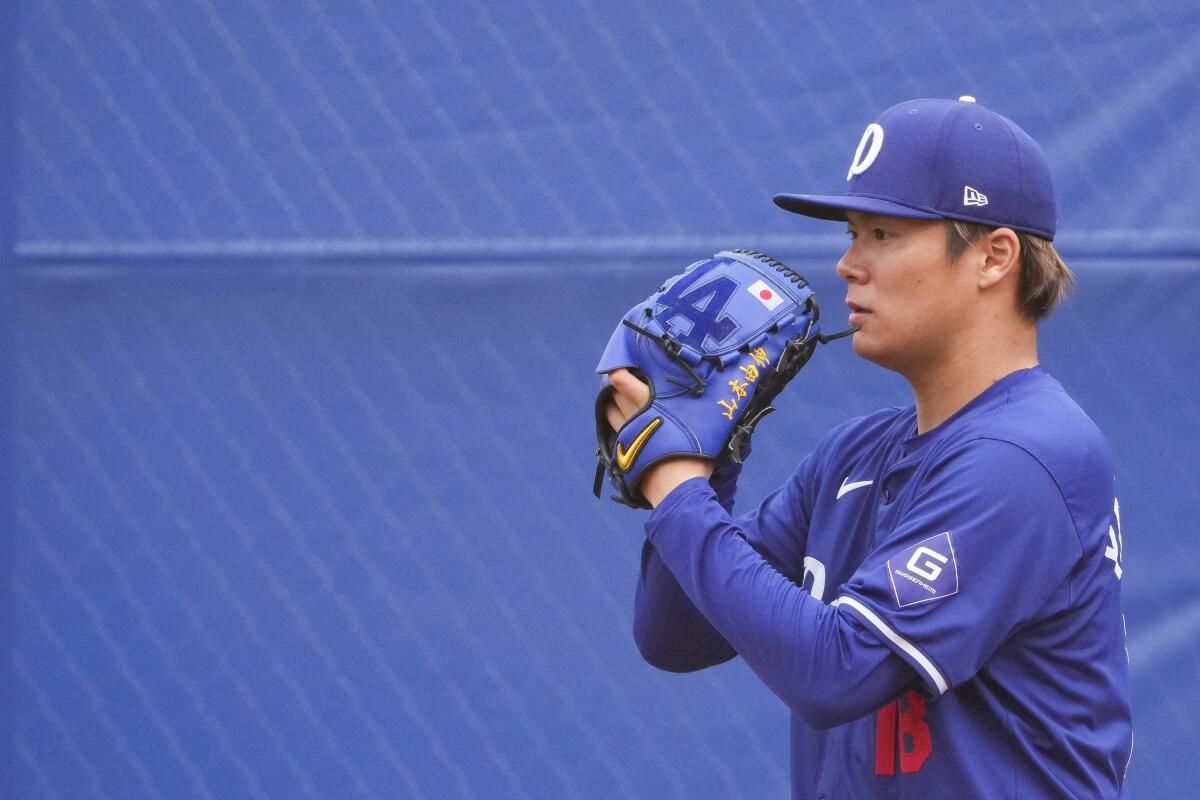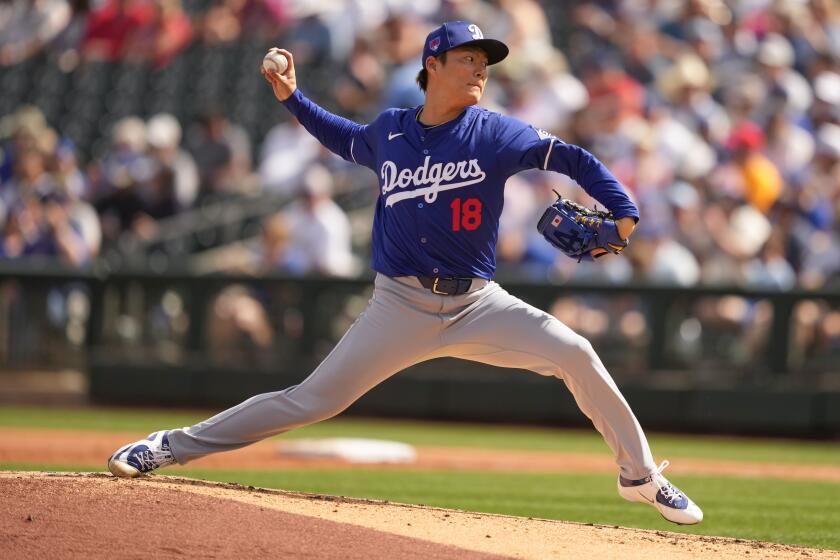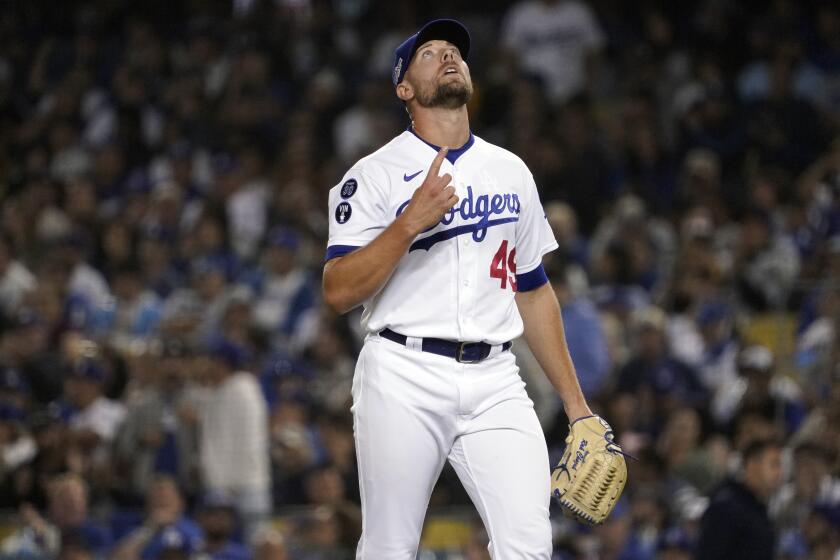Dodgers’ Yoshinobu Yamamoto says tipping pitches ‘not really a big concern’ for him

- Share via
PHOENIX — It took all of one exhibition start for Yoshinobu Yamamoto to be exposed to some of the “dark arts” practiced in the major leagues, with SportsNet LA broadcasters noting during Yamamoto’s Feb. 28 Cactus League debut that the center-field camera caught him changing his grip before throwing his signature split-fingered fastball.
The 25-year-old Japanese right-hander, who will make his second exhibition start against the Chicago White Sox at Camelback Ranch on Wednesday, was hardly fazed, shrugging off the potential pitch-tipping development when it was brought to his attention earlier this week.
“It’s not really a big concern for me at this point,” Yamamoto said through his interpreter, Yoshihiro Sonoda. “As it gets closer to the season, I’ll talk to the coaches and fix it. It was the same in Japan. When the season starts, I’ll make those adjustments.”
Baseball cracked down on the use of in-game video feeds in the wake of the Houston Astros’ sign-stealing scandal, but teams can study video of pitchers before and after games, and a runner on second base can relay a signal to a batter if he can get a clear look at a pitcher’s grip before a pitch.
“We’re pretty vigilant about it with all of our guys, and we try to clean it up as much as we can,” Dodgers pitching coach Mark Prior said. “It’s something I think from [Yamamoto’s] perspective that he is going to learn.
And though it’s too early to know exactly how smooth Yamamoto’s MLB transition will go this season, his ability to adapt behind-the-scenes is already standing out.
“From my understanding, that’s not something that is actively practiced in [Japan], where obviously over here, it’s much more of an active program by all 30 teams. Everybody’s aware of it and, look, it’s part of the game.”
Yamamoto gave up one single and struck out three in two scoreless innings against the defending World Series champion Texas Rangers last week, touching 96 mph with his fastball and mixing in a wicked combination of soft curveballs, sharp-breaking cut fastballs and nosediving splitters. Of his 19 pitches, 16 were strikes.
Yamamoto’s grip could be seen in the feed from the center-field camera when he was pitching out of a windup, which he starts by holding his pitching hand in his glove at about neck height. It should be much tougher to discern Yamamoto’s grip when he is pitching out of the stretch.
“There’s always different things that you’re looking for — what can hitters actually see? What can hitters actually react to in time? Do you need a runner on second base?” Prior said. “There’s different variations of tipping. Sometimes it’s a glove. Sometimes it’s tempo. Sometimes it’s a guy sticking his tongue out. At the end of the day, you’re trying to figure out what is actually actionable for a hitter to act on in real time.
“It has to be a focus because it’s part of the game. It’s not a one-off anymore. It’s pretty much every team employing some version of it, whether it’s players switching teams, whether it’s coaches. These guys are really good at it.”
Yamamoto, who signed the largest contract ever awarded to a pitcher — 12 years and $325 million — before throwing his first big-league pitch, has enough on his plate with his transition to a new country, a new culture, a new team and a new league.
The 5-foot-10, 176-pounder will have to contend with deeper lineups filled with more powerful hitters than the ones he faced in Japan, a more grueling travel schedule and a baseball that is less tacky compared to what he was used to in Japan.
The last thing the Dodgers probably want to do just two weeks before their season-opening series against the San Diego Padres in Seoul is overburden Yamamoto’s mind with concerns about pitch tipping or make any alterations to his delivery that might negatively impact his stuff.
“Everything matters, but what the solution is sometimes isn’t always black and white,” Prior said. “You have to weigh the cost of … if you make moves, does that change the delivery? Does that change the stuff?
“You have to weigh the pros and cons. Is it something we want to act on or make a big deal out of or raise the level of concern? There are other times where we let things kind of just play out and see what happens.”
Yamamoto’s transition to the Dodgers, whose $1.2-billion winter spending spree included the signing of two-way star Shohei Ohtani to a 10-year, $700-million deal, has been seamless so far, and he appears comfortable with his new surroundings.
“So far, there’s been no problems,” said Yamamoto, who won the past three Pacific League most valuable player awards and Sawamura Awards, the Japanese equivalent of the Cy Young Award. “I’m getting all the support I need from the whole organization, my teammates and the staff.”
Blake Treinen is 2½ years and one major shoulder surgery removed from his dominant 2021 season, but there are signs this spring he could reclaim a prominent role.
But spring training is relaxed and stress-free compared to the regular season, when Yamamoto will have to cope with the pressure to live up to his massive contract and to be an integral part of a team with a $300-million payroll and expectations of winning the World Series.
“You know, time will tell,” Prior said when asked how he expects Yamamoto will handle the pressure. “I don’t think anybody ever actually knows. But you bet on the track record, you bet on being the best pitcher in [Nippon Professional Baseball] for the last few years, pitching in the [World Baseball Classic] against big names.
“You look at all those things, the way he works, the discipline he has, I mean, it’s the same as placing a bet on a free agent here. You try to do as much background research as you can, and at the end of the day, you’re placing faith in your organization’s ability to gather information and place a bet on who this guy is based on what he’s done already.
“I don’t really get into the finances of it all, but based on what I’ve seen, he takes this very seriously, and he wants to be one of the best pitchers in Major League Baseball.”
More to Read
Are you a true-blue fan?
Get our Dodgers Dugout newsletter for insights, news and much more.
You may occasionally receive promotional content from the Los Angeles Times.








